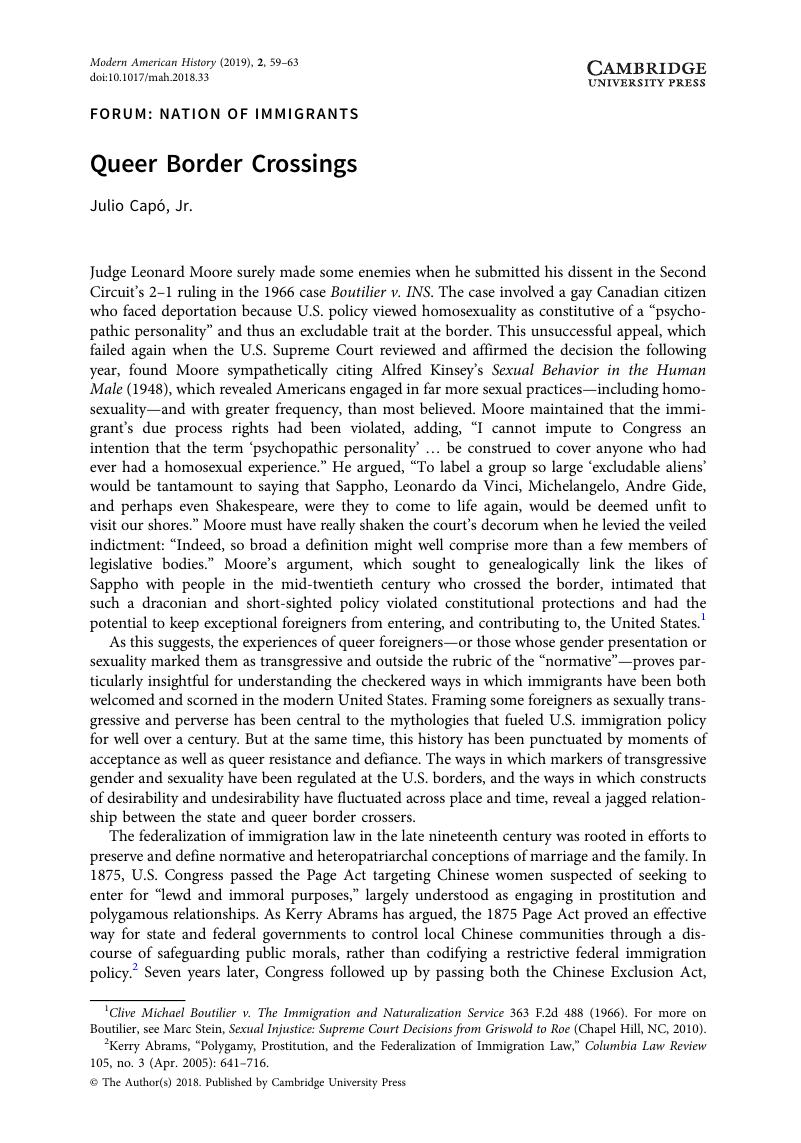No CrossRef data available.
Article contents
Queer Border Crossings
Published online by Cambridge University Press: 20 November 2018
Abstract

Keywords
- Type
- Forum: Nation of Immigrants
- Information
- Copyright
- Copyright © The Author(s) 2018. Published by Cambridge University Press
References
1 Clive Michael Boutilier v. The Immigration and Naturalization Service 363 F.2d 488 (1966). For more on Boutilier, see Stein, Marc, Sexual Injustice: Supreme Court Decisions from Griswold to Roe (Chapel Hill, NC, 2010)Google Scholar.
2 Abrams, Kerry, “Polygamy, Prostitution, and the Federalization of Immigration Law,” Columbia Law Review 105, no. 3 (Apr. 2005): 641–716Google Scholar.
3 Luibhéid, Eithne, Entry Denied: Controlling Sexuality at the Border (Minneapolis, 2002), 3Google Scholar.
4 Canaday, Margot, The Straight State: Sexuality and Citizenship in Twentieth-Century America (Princeton, NJ, 2009), ch. 1Google Scholar.
5 Ibid., 38.
6 Skidmore, Emily, True Sex: The Lives of Trans Men at the Turn of the Twentieth Century (New York, 2017), 80CrossRefGoogle Scholar.
7 Capó, Julio Jr., Welcome to Fairyland: Queer Miami before 1940 (Chapel Hill, NC, 2017), ch. 2CrossRefGoogle Scholar.
8 Erman, Sam, “Meanings of Citizenship in the U.S. Empire: Puerto Rico, Isabel Gonzalez, and the Supreme Court, 1898 to 1905,” Journal of American Ethnic History 27, no. 4 (Summer 2008): 5–33Google Scholar.
9 Surely, the 1917 Immigration Act included a provision excluding those deemed “constitutional psychopathic inferiors,” but, despite the medicalization of homosexuality that persisted since the late nineteenth century, it did not function to weed out “sexual perverts.” Canaday, The Straight State, 50n112.
10 Johnson, David K., The Lavender Scare: The Cold War Persecution of Gays and Lesbians in the Federal Government (Chicago, 2004)Google Scholar.
11 Report of the Public Health Service on the Medical Aspects of H.R. 2379, May 15, 1951, House Report No. 1365, 82 Cong. 2nd Sess., Feb. 14, 1952, 47.
12 Stein, Sexual Injustice, 3.
13 Somerville, Siobhan B., “Queer Loving,” GLQ: A Journal of Lesbian and Gay Studies 11, no. 3 (2005): 335–70, here 357CrossRefGoogle Scholar.
14 Capó, Julio Jr., “Queering Mariel: Mediating Cold War Foreign Policy and U.S. Citizenship among Cuba's Homosexual Exile Community, 1978–94,” Journal of American Ethnic History 29, no. 4 (Summer 2010): 78–106Google Scholar. It is impossible to ignore the numerous exceptional policies that benefited Cubans—and certain other immigrant groups—fleeing communism in the midst of the Cold War just as the U.S. federal government unrolled new racialized policies of interdiction and restriction targeting Haitians, for example, fleeing a right-wing dictatorship. See Paik, A. Naomi, “Carceral Quarantine at Guantánamo: Legacies of US Imprisonment of Haitian Refugees, 1991–1994,” Radical History Review 2013, no. 115 (Winter 2013): 142CrossRefGoogle Scholar; Kraut, Alan M., Silent Travelers: Germs, Genes, and the Immigrant Menace (Baltimore, 1995)Google Scholar. See, in this forum, Lipman, Jana, “Immigrant and Black in Edwidge Danticat's Brother, I'm Dying,” Modern American History 2, no. 1 (March 2019)Google Scholar. https://doi.org/10.1017/mah.2018.32
15 See Shah, Nayan, Contagious Divides: Epidemics and Race in San Francisco's Chinatown (Berkeley, CA, 2001)Google Scholar.
16 See Yesenia Acosta, “Green Cards Still Elusive for Many Same-Sex Couples,” Advocate, Feb. 26, 2016, https://www.advocate.com/commentary/2016/2/26/green-cards-still-elusive-many-same-sex-couples (accessed June 12, 2018).
17 For more on the UndocuQueers, see “Equality Archive,” n.d., https://equalityarchive.com/issues/undocuqueer-movement/ (accessed Jan. 31, 2018).


